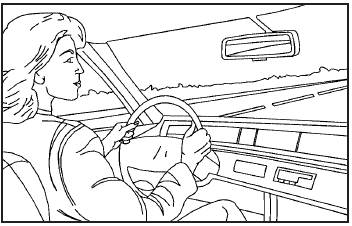Steering in Emergencies
There are times when steering can be more effective than braking. For example, you come over a hill and find a truck stopped in your lane, or a car suddenly pulls out from nowhere, or a child darts out from between parked cars and stops right in front of you. These problems can be avoided by braking — if you can stop in time. But sometimes you cannot stop in time because there is no room. That is the time for evasive action — steering around the problem.
The vehicle can perform very well in emergencies like these. First apply the brakes. See Braking.
It is better to remove as much speed as possible from a collision. Then steer around the problem, to the left or right depending on the space available.

An emergency like this requires close attention and a quick decision. If holding the steering wheel at the recommended 9 and 3 o’clock positions, it can be turned a full 180 degrees very quickly without removing either hand. But you have to act fast, steer quickly, and just as quickly straighten the wheel once you have avoided the object.
The fact that such emergency situations are always possible is a good reason to practice defensive driving at all times and wear safety belts properly.
See also:
Saving MEM Tracks as
Favorites
Favorites can be saved by pressing
and holding one of the 1 to
6 buttons. Favorites can be stored
according to the following list:
Playlist: Adds the currently playing
track to the playlist s ...
To Use the Engine Heater
1. Turn off the engine.
2. Open the hood and unwrap the electrical cord. The electrical cord is located
on the passenger side of the engine compartment, near the air cleaner.
3. Plug it into a n ...
Erasing Universal Home Remote
Buttons
The programmed buttons should be erased when the
vehicle is sold or the lease ends.
To erase either Rolling Code or Fixed Code on the
Universal Home Remote device:
1. Press and hold the two outs ...


